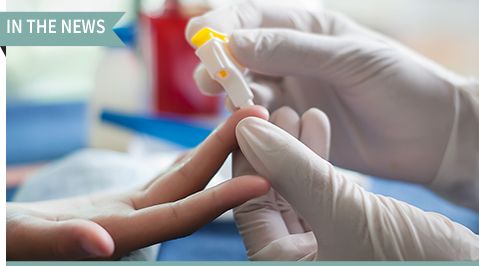 Image credit: jarabee123/Thinkstockphotos.com
Image credit: jarabee123/Thinkstockphotos.com
A U.S. Food and Drug Administration (FDA) advisory panel charged with reviewing the evidence behind the first point-of-care (POC) diagnostic test for diabetes disbanded without a vote in late July, leaving the fate of the Alere Afinion HbA1c Dx test system up to the agency. The FDA typically convenes such panels to provide a recommendation on approval. Although it is not required to follow the advice of such panels, it typically does.
The Clinical Chemistry and Clinical Toxicology Devices Panel met July 22 to consider the assay, which is designed for use in moderate-complexity POC settings.
The system is identical to one already used to monitor patients with diabetes. That test has received a Clinical Laboratory Improvement Amendments (CLIA) waiver and can be used in numerous POC clinical settings with no required training. However, Alere outlined several ways it would separate the two tests.
POC diabetes diagnostics is somewhat controversial. The American Diabetes Association (ADA) did not recommend such assays for diagnostic purposes in its 2016 guidelines, citing a lack of required proficiency testing. The missing support is the main reason the FDA asked for the panel review.
Using the test to monitor patients already diagnosed with diabetes is appropriate, said ADA chief scientific and medical officer Robert E. Ratner, MD, because it doesn’t require the same degree of accuracy as a diagnostic test.
However, Richard Kahn, PhD, a clinical professor of medicine at the University of North Carolina in Chapel Hill, disputed that claim, arguing that POC testing could improve the diagnosis of diabetes (currently about a third of people with diabetes are undiagnosed) with little risk of false positives or negatives.
Alere executives stressed that proficiency testing would be required for those providing the test. However, the company’s vice president of clinical affairs, Rick San George, PhD, told the panel that Alere is considering a future request for a CLIA waiver.
Supporters of POC HbA1c testing emphasized its advantages, particularly the increased access it affords patients and the potential for more timely treatment changes that could improve glycemic control. Such tests also enable clinicians to discuss the results with patients before they leave the exam room, rather than requiring a follow-up visit.
In accuracy studies of the Alere Afinion HbA1c Dx, the total error estimates for the test based on venous whole blood precision estimates ranged from 2.25% to 3.16%, within the acceptance criterion for total error. The total error estimates for the test based on fingerstick whole blood ranged from 1.41% to 4.05%, also within the acceptance criterion of less than 6%.
While some media outlets reported that the FDA panel had backed the test, the panel never actually voted. Based on members’ comments, it appears that most supported the test for use in moderate-complexity settings requiring proficiency testing. However, some expressed concerns over its use in CLIA-waived settings.
However, as one panelist noted, clinicians are already using their POC HbA1c machines, which are approved to monitor glucose levels in people with diabetes, “off label” as a diagnostic tool.
The decision on approval for the diagnostic version of the test now rests with the FDA.